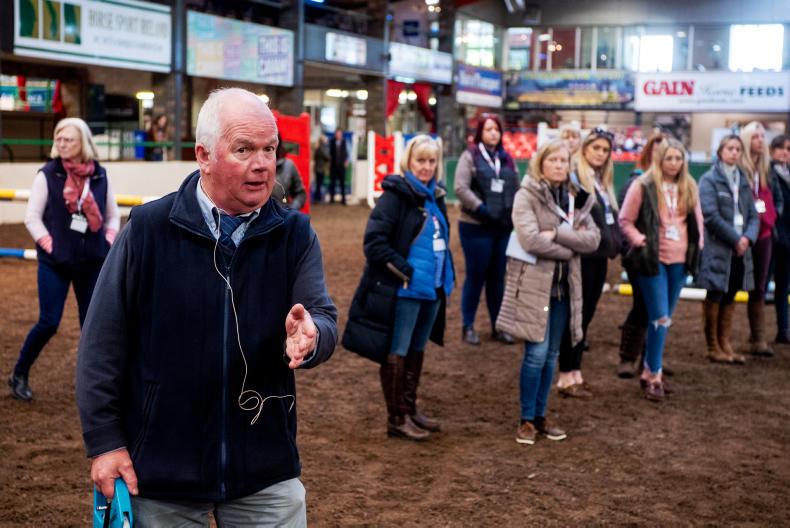INTERNATIONAL course builder and designer Tom Holden gave a two-part interactive demonstration at the British Horse Society (BHS) National Convention at Cavan Equestrian Centre last week. The demonstrations focused on designing and building a simple course for training at home that can be ridden in a different ways with varying levels of difficulty.
Holden is an FEI level 3 course designed and is also a Horse Sport Ireland level 2 coach and Tutor. He has designed and built show jumping courses across Europe and in America and Canada, including a number of World Cup qualifiers.
For seven of the last eight years Holden has designed the course for the CSIYH 1* (seven and eight-year-olds) class at the Dublin Horse Show. In 2017 he was responsible for designing the courses at the CSIO 5* Dublin Horse Show, including the courses for the Aga Khan Trophy and for the Grand Prix.
Building the course
The first part of the session was on building the course. Before lunch on the first day of the convention, the audience were invited into the arena at Cavan Equestrian Centre to build the course with Holden.
The course Holden designed was very simple and only consisted of six fences. He emphasised how riders can train for the type of courses they are likely to meet in competition using a series of simple lines and that you do not need to have a huge amount of equipment to train for competition.
The course consisted of three line, one straight line related distance and two bending lines. Holden explained how this course could be jumped in two ways, the first was easier and more suitable for younger horses and the second was more technical. Both of the bending line could be ridden in either direction which allowed the riders to progress to the more challenging course very easily.
He also gave a third variation to the course which involved adding one more fence into the straight line related distance to build a treble combination.

Ridden demonstration
The second, and longer of the two demonstrations, took place after lunch. Holden worked with three event riders: Louise Bloomer, Emma Newsam and Jim Newsam.
He began the exercise using canter poles, explaining how this is a very good way of training both the horse and rider without putting additional strain on the horse’s legs by constantly jumping.
Holden coached the riders through each of the related distances on their own first and then progressed to getting the riders to ride the course of canter poles. The focus was always on getting the correct canter and stride pattern on each distance. Holden explained how adding a stride on a distance is not necessarily a bad thing in terms of the distance but it can impact on whether you make the time allowed or not. He said: “You add 0.6 seconds for every extra stride you put in.”
He went on to make some of the canter poles into jumps. Holden explained that the distance was built as a fence-to-fence distance, this was then shorted when the distance was canter pole to canter pole, then lengthened slightly when it was canter pole-fence or fence to canter pole, and finally it was lengthened back to the true distance when it was fence to fence.
Holden asked the riders to ride the bending lines as a canter pole to a fence, however, he asked them to ride the straight line distance going fence to a canter pole. He explained this is a very important exercise because it trains both horse and rider to establish the correct canter after the fence as well as before the fence. Holden asked each of the rider to focus on straightness while the canter poles and smaller fences, while also maintaining a focus on the correct canter and stride pattern.
Course of fences
Holden began with the easier course. The riders jumped the bending six stride, to the bending seven stride and then the straight five stride distance.
Throughout the entire session he maintained very open lines of communication between himself and the riders. After each round, whether it was of canter poles or fences, Holden asked each rider to talk him through how they felt the round was. Show jumping courses often consist of around 14 fencee, including at least one double or treble. Because this exercise is comprised of six fences it means you can repeat the exercise without putting the horse under strain.
The harder variation of the course included two roll-back turns. Riders started with the five stride straight line, to bending six stride to the seven stride bending line. Holden explained how the two variations of the course help to train for competition: “The whole point of an exercise like this is to getting horses used to fences coming up in quick succession and getting the riders used to making adjustments.”
The final variation to the course Holden built added a treble into five stride straight line distance in the first course. The treble had two strides between each element.
“Practice so you don’t have to introduce something new on the day of competition,” said Holden. He went on to explain how he feels show jumping is going to continue to have more of an impact on eventing and therefore, riders need to consider how they train for it.